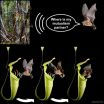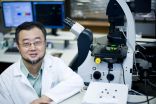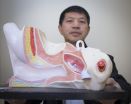(Press-News.org) In Borneo, some insectivorous bats have developed a rather intriguing relationship with carnivorous pitcher plants. The plants offer the bats a relatively cool place to roost, free of parasites and competition from other bats. In return, the bats keep the plants well fertilized with their droppings. Now, researchers reporting in the Cell Press journal Current Biology on July 9 show that the plants rely on special structures to reflect the bats' ultrasonic calls back to them. That adaptation of the plants makes it easier for bats to find their plant partners in the cluttered forest.
"With these structures, the plants are able to acoustically stand out from their environments so that bats can easily find them," says Michael Schöner of Ernst-Moritz-Arndt-University of Greifswald in Germany. "Moreover, the bats are clearly able to distinguish their plant partner from other plants that are similar in shape but lack the conspicuous reflector."
It all started when study author Ulmar Grafe of the University Brunei Darussalam discovered bats roosting inside pitcher plants. He, along with Michael and Caroline Schöner and Gerald Kerth, senior author of the new study, first explored what the plants and their bat partners were each getting out of the deal. Their findings--that the plants offer bats a place to roost in return for nitrogen--helped to explain something that had vexed pitcher plant researchers: those plants, Nepenthes hemsleyana, are rather bad at attracting insects, compared to their carnivorous relatives.
In the new study, the researchers wondered how N. hemsleyana and the bats, Kerivoula hardwickii, find each other. After all, both species are relatively rare, and they live in a rather crowded place. That led the researchers to an idea: "Wouldn't it be neat if pitchers somehow advertised their presence to the bats?"
In fact, some neotropical flowers have a similar problem: they depend on nectar-feeding bats to pollinate them. Some of those plants have dish-shaped petals or leaves to reflect echoes of strong intensity when, for instance, a bat is calling towards them. Those reflectors allow the plants to stand out from their surroundings so that the bats can easily find them. It now appears that the unrelated pitcher plant N. hemsleyana does the same thing, but for a different reason.
The researchers recruited Ralph Simon from the University of Erlangen-Nuremberg to their team. Simon had been studying the acoustic adaptations of bat-pollinated flowers for some time. In Borneo, Simon and his colleagues used an artificial biomimetic bat head that emits and records ultrasounds to test the pitchers' acoustic reflectivity from different positions and angles. Those studies uncovered a strong echo reflection from the pitchers' back walls, where the plant form works perfectly as an effective reflector.
Behavioral experiments showed that the bats respond to those sounds echoed back to them from the plants. Bats were better at finding partially hidden pitcher plants when their reflectors were intact than when the reflector had been reduced. The bats also chose pitcher plants more often as the best places to roost when the reflector had not been reduced.
The study is yet another fascinating example of how nature and evolution solve problems, the researchers say.
"Carnivorous plants in general have already solved the problem of nutrient deficiency in a very unusual way by reversing the 'normal system' of animals feeding on plants," Schöner says. "It is even more astonishing that in the case of N. hemsleyana the system is taking a new turn. While N. hemsleyana reduced many insect-attracting traits, it obviously exhibits some traits that are highly attractive for a species that provides the plants with nutrients without being digested by the plant itself."
INFORMATION:
Current Biology, Schöner and Schöner et al.:"Bats Are Acoustically Attracted to Mutualistic Carnivorous Plants" http://dx.doi.org/10.1016/j.cub.2015.05.054
Current Biology, published by Cell Press, is a bimonthly journal that features papers across all areas of biology. Current Biology strives to foster communication across fields of biology, both by publishing important findings of general interest and through highly accessible front matter for non-specialists. For more information please visit http://www.cell.com/current-biology. To receive media alerts for Current Biology or other Cell Press journals, contact press@cell.com.
A new technique that uses light to activate chemotherapy drugs in specific cells shows promise as a way to improve the effectiveness of cancer therapies while preventing severe side effects, according to a study published July 9 in Cell. The so-called photopharmacology approach could be used to treat a broad range of tumors with unprecedented precision simply by making existing cancer drugs sensitive to light--an approach that requires less time and effort compared with traditional drug discovery programs.
"We hope that our compounds will one day be used in medicine to ...
CAMBRIDGE, MA -- The "friendly" bacteria inside our digestive systems are being given an upgrade, which may one day allow them to be programmed to detect and ultimately treat diseases such as colon cancer and immune disorders.
In a paper published today in the journal Cell Systems, researchers at MIT unveil a series of sensors, memory switches, and circuits that can be encoded in the common human gut bacterium Bacteroides thetaiotaomicron.
These basic computing elements will allow the bacteria to sense, memorize, and respond to signals in the gut, with future applications ...
While human activities have caused extinctions across the globe, your favourite beach or diving site may actually be home to as many, or more, species then it was a few decades ago.
That's the conclusion of a synthesis of 50 years of marine biodiversity data conducted by University of British Columbia (UBC) researchers.
But there is a catch. Like other studies of its kind, the synthesis relies on species population time series from sites that haven't been subject to intense human development.
"Much as you'd expect, our study shows human impacts like pollution and ...
A study to examine recessively inherited genome-wide DNA sequences has for the first time discovered a potential link with Britain's biggest killer - Coronary Artery Disease (CAD).
The research led by a team from the University of Leicester was the first time that recessively inherited DNA sequences in the whole genome called Runs of homozygosity (ROHs) were examined for a connection to the disease.
The study appears in the American Journal of Human Genetics.
CAD is a terminal clinical manifestation of cardiovascular disease and is the leading cause of death worldwide ...
Danish researchers are the first in the world to have used our genes to investigate the impact of coffee on the body. The new study shows that coffee neither increases nor decreases the risk of lifestyle diseases.
We love coffee - and we drink a lot of it. New research from the University of Copenhagen and Herlev and Gentofte Hospital shows that coffee neither increases nor decreases the risk of developing lifestyle diseases such as obesity and diabetes. The researchers have based their study on genes, as our genes play a role in how much coffee we drink in the course ...
DENVER (July 9, 2015) - A new study from the University of Colorado Denver finds that male exotic dancers, or strippers, remain committed to stripping because it enhances their self-concept.
The study by Maren Scull, an instructor of Sociology in the CU Denver College of Liberal Arts and Sciences, was published online this month in Deviant Behavior, the only scientific journal that specifically addresses behaviors that violate social norms. Scull's research focuses on how exotic dancing influences the way male strippers view themselves.
"Because stripping is a stigmatizing ...
This news release is available in French.
Since the treatment has become available, HIV is often described as "undetectable" and the risk of transmission has been drastically reduced. However, the epidemic is still quite present in the lives of many gay and bisexual men... and in public spaces. This often overlooked dimension of the disease has been brought to light by Gabriel Girard of the University of Montreal's Public Health Research Institute (IRSPUM) - HIV is still alive in the city, especially in the Village, Montreal's gay district. "Urban traces are significant ...
WEST LAFAYETTE, Ind. -- A key set of immune cells that protect the body from infection would be lost without directions provided by vitamin A, according to a recent study.
A team of researchers from Purdue University found retinoic acid, a metabolite that comes from digested vitamin A, is necessary for two of the three types of innate immune cells that reside in the intestine to find their proper place.
"It is known that vitamin A deficiencies lead to increased susceptibility to disease and low concentrations of immune cells in the mucosal barrier that lines the intestines," ...
MADISON, Wis. -- A study authored by two University of Wisconsin-Madison graduate students indicates that while playing video games can improve mood, violent games may increase aggressive outcomes.
The study, authored by James Alex Bonus and Alanna Peebles, graduate students in Communication Arts, and Karyn Riddle, assistant professor in the School of Journalism and Mass Communication, was published in June in the journal Computers in Human Behavior. The researchers looked at how video games may be used to manage emotions -- specifically, whether playing the games can ...
(Edmonton) Screening newborn babies who are in the neonatal intensive care unit (NICU) using a testing process called high-frequency tympanometry can help identify middle-ear problems earlier, according to newly published research from a local team of researchers.
"If people cannot hear, we need to know if the problem is with the middle ear, inner ear or hearing nerve. Obviously, a baby cannot tell you, so in the clinic it's hard to know when they have hearing loss," explained Ming Zhang, an associate professor at the U of A's Department of Communication Sciences and ...






